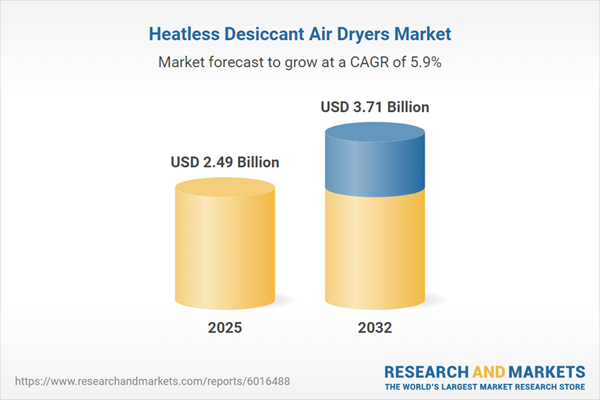Speak directly to the analyst to clarify any post sales queries you may have.
Heatless desiccant air dryers are now a strategic cornerstone for senior decision-makers steering industrial operations. As organizations emphasize reliability, compliance, and adaptability, adopting advanced air treatment systems is integral for safeguarding performance and meeting future demands.
Market Snapshot: Heatless Desiccant Air Dryers Market Growth
The heatless desiccant air dryers market is experiencing stable expansion, with a current valuation of USD 2.35 billion expected to grow to USD 2.49 billion in 2025. Projections indicate a market size of USD 3.71 billion by 2032, reflecting a compound annual growth rate (CAGR) of 5.87%. This trend is shaped by evolving quality standards, innovations in adsorption processes, and industry-wide adoption of digital monitoring. Heightened demand is particularly evident in sectors where pristine air quality is essential, pushing both resilience and operational effectiveness to the forefront.
Scope & Segmentation
- End Use: Chemical and petrochemical users prioritize air dryness to ensure safe, reliable production processes and product quality. The food and beverage industry seeks contamination prevention from source to packaging. Healthcare and pharmaceutical manufacturing maintain strict air purity for regulatory compliance and sensitive operational protocols. Power generation focuses on system reliability, emphasizing continuous uptime amid complex facility conditions.
- System Types: Double tower models dominate continuous and demanding workflows by minimizing system downtime and boosting output continuity. Multi-tower designs meet the needs of expansive, high-throughput plants, while single tower units cater to compact installations focused on specific reliability goals.
- Flow Rate Segmentation: Facilities select dryers based on required airflow: up to 500 CFM targets localized or specific processes, 500–1000 CFM aligns with mid-size installations, and systems above 1000 CFM address high-capacity settings with advanced control requirements.
- Installation Methods: Portable units allow for rapid shifts in plant layout or evolving production lines. Stationary models support long-term integration, automated controls, and stable operations within permanent facility footprints.
- Sales Channels: Direct sales deliver tailored engineering and project support for custom requirements. Indirect distribution networks broaden accessibility, streamlining procurement for regional and remote plants.
- Regional Breakdown: Coverage includes the Americas—focused on North, Central, and South American nations; Europe, the Middle East, and Africa, encompassing mature and emerging markets; and Asia-Pacific, spanning highly industrialized economies and those with accelerating infrastructure investments.
- Company Coverage: Leading vendors are represented, including Atlas Copco AB, Ingersoll Rand, Inc., Kaeser Kompressoren SE, Sullair LLC, Parker-Hannifin Corporation, F.S. Elliott Co. LLC, Boge Kompressoren GmbH, ELGi Equipments Limited, Aerzener Maschinenfabrik GmbH, and Mattei Compressors S.p.A.
Key Takeaways for Senior Decision-Makers
- Heatless desiccant air dryers safeguard critical workflows by delivering precise moisture management, supporting safety in operations where clean air is essential.
- Technological advancements in desiccant materials, automation, and digital monitoring enhance system performance and enable predictive maintenance, reducing disruption risk.
- Sustainability goals are influencing procurement, with an increasing focus on energy efficiency, optimized purge cycles, and extended equipment lifespan, aligning with evolving environmental mandates.
- Diverse purchasing channels and localized support allow organizations to remain flexible as compliance pressures and production strategies shift.
- Scalable system architectures enable adaptation to capacity changes or operational transitions, ensuring long-term investment efficiency.
- Regional preferences vary: North American buyers focus on compliance and quality; EMEA manufacturers emphasize durability for challenging sites; Asia-Pacific markets experience rising adoption fueled by infrastructure development and tightening manufacturing criteria.
Tariff Impact and Supply Chain Trends
Current tariff developments, particularly in the United States, are prompting manufacturers of heatless desiccant air dryers to adapt sourcing and production frameworks. Shifts include expanding domestic manufacturing, broadening the supplier base, and updating inventory strategies. These responses are designed to shield operations from regulatory and trade volatility, ensuring stable supply chains and consistent product access worldwide.
Methodology & Data Sources
This analysis incorporates a blend of secondary reviews of technical publications, interviews with engineers and operations managers, and sustainability feedback. Structured triangulation with recognized industry benchmarks validates insights, ensuring data integrity and actionable recommendations for senior executives.
Why This Report Matters
- Organizations can align investment and asset planning with dynamic industry demands for compressed air treatment solutions.
- Decision-makers gain insight on technology, regulatory changes, and procurement innovation, informing risk management and strategic expansion initiatives.
- The research supports targeted system improvements and resource planning for robust, future-ready air management programs.
Conclusion
Heatless desiccant air dryers are vital for modern air quality management. Ongoing technology enhancements and adaptive procurement strategies position organizations to respond confidently to evolving operational requirements.
Additional Product Information:
- Purchase of this report includes 1 year online access with quarterly updates.
- This report can be updated on request. Please contact our Customer Experience team using the Ask a Question widget on our website.
Table of Contents
3. Executive Summary
4. Market Overview
7. Cumulative Impact of Artificial Intelligence 2025
Companies Mentioned
The companies profiled in this Heatless Desiccant Air Dryers market report include:- Atlas Copco AB
- Ingersoll Rand, Inc.
- Kaeser Kompressoren SE
- Sullair LLC
- Parker-Hannifin Corporation
- F.S. Elliott Co. LLC
- Boge Kompressoren GmbH
- ELGi Equipments Limited
- Aerzener Maschinenfabrik GmbH
- Mattei Compressors S.p.A.
Table Information
| Report Attribute | Details |
|---|---|
| No. of Pages | 197 |
| Published | November 2025 |
| Forecast Period | 2025 - 2032 |
| Estimated Market Value ( USD | $ 2.49 Billion |
| Forecasted Market Value ( USD | $ 3.71 Billion |
| Compound Annual Growth Rate | 5.8% |
| Regions Covered | Global |
| No. of Companies Mentioned | 11 |









